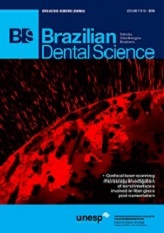Evaluation of the condylar position in subjects with signs and symptoms of functional disorders of the temporomandibular joint through images made with cone beam computed tomography on the sagittal plane
DOI:
https://doi.org/10.14295/bds.2014.v17i2.968Resumo
ABSTRACT: The aim of the study was to investigate the condylar position within the articular cavity in patients with temporomandibular disorders with signs and symptoms of functional articular disorders through images made with cone beam computed tomography (CBCT) on the sagittal plane. Methods: CBCT temporomandibular joints images of 62 patients (13 men and 49 women, average age, 39.7 years) with signs and symptoms intra-articular diagnosed by the Craniomandibular index were analyzed using the measurement method recommended by Kawamura and Ikeda (2009). We obtained the linear measures of posterior space (PS), superior space (SS), and the anterior space (AS) to determine the condyle position for each joint. Results: The average of the measurements of PS, SS, were respectively 1.9 mm (DP 0.5), 3.1 mm (DP 0.9), and 2.0 mm (DP 1.0). Conclusion: This study found that the subjects with intra-articular TMD when compared with the excellent condylar relationship established by Ikeda and Kawamura (2009) presented a more posterior and inferior condylar position.
Downloads
Downloads
Publicado
Como Citar
Edição
Seção
Licença
TRANSFERÊNCIA DE DIREITOS AUTORAIS E DECLARAÇÃO DE RESPONSABILIDADE
Toda a propriedade de direitos autorais do artigo "____________________________________________________________________" é transferido do autor(es) para a CIÊNCIA ODONTOLÓGICA BRASILEIRA, no caso do trabalho ser publicado. O artigo não foi publicado em outro lugar e não foi submetido simultaneamente para publicação em outra revista.
Vimos por meio deste, atestar que trabalho é original e não apresenta dados manipulados, fraude ou plágio. Fizemos contribuição científica significativa para o estudo e estamos cientes dos dados apresentados e de acordo com a versão final do artigo. Assumimos total responsabilidade pelos aspectos éticos do estudo.
Este texto deve ser impresso e assinado por todos os autores. A versão digitalizada deverá ser apresentada como arquivo suplementar durante o processo de submissão.




























